Why all the fuss about grass-fed beef? And why are its producers having trouble keeping up with skyrocketing demand? Many people have embraced grass-fed beef because of ethical, environmental or health concerns, but the most immediately rewarding reason of all may be flavor: Grass-fed beef has a terroir — its taste depends on where it comes from and what kinds of grasses the cow has been eating. It’s more robust and savory — just plain “beefier” than its grain-fed counterpart. And it’s much more nutritious.
As a rule, grass-fed cattle haven’t been exposed to the GMOs and growth hormones used in conventional beef production, nor do they contain arsenic or high levels of copper as does meat from animals raised in feedlots. And raising cattle on pastures according to the rhythms of nature, as opposed to a factory approach, keeps us — and the planet — healthier for other reasons, too. Cows that are raised on pasturelands, roaming freely in the sunshine and fresh air, are better nourished, less stressed and less vulnerable to infection. They rarely need antibiotics. That reduces the risk of creating more antibiotic-resistant strains of bacteria, which keeps our medicines more effective. Grassland pastures themselves reduce heat-trapping greenhouse gases and decrease erosion, leading to healthier waterways and wildlife habitats.
Because grass-fed cuts are typically more flavorful (and more expensive) than their conventional counterparts, you may want to consider small to moderate (3 to 6 ounce) portions and cook with care. Grass-fed beef has a lower fat content and can get tough when overcooked, so sear the outside very quickly, then cook low and slow to preserve juiciness. Read on to learn more about grass-fed beef’s benefits — and how to make the most of its flavors.
Nutrition Know-How
- Grass-fed beef is high in antioxidants like beta-carotene, which helps with immune function, and CoQ10, an enzyme that supports heart and circulatory-system health.
- While grass-fed beef is lower in fat overall than grain-fed beef, it has a higher percentage of good fats like omega-3 fatty acids and conjugated linoleic acid (CLA), both of which may help prevent heart disease, diabetes and some cancers. Omega-3 fatty acids have an anti-inflammatory effect on the body and support healthy brain function. CLA is important for immune function, blood-sugar regulation and for stimulating fat burning in the body.
- While our bodies need both omega-6 and omega-3 essential fatty acids, studies have shown that if the proportion of omega-6 to omega-3 exceeds 4:1, people have more health problems (experts say the ideal ratio is between 1:1 and 3:1). The average American diet has a ratio of 15:1. Grain-fed beef can have a ratio of 20:1, but grass-fed is about 2:1 or 3:1.
- Saturated fats from whole foods are an important — even vital — part of a healthy diet. They help the body absorb minerals, serve as building blocks for cell membranes and a variety of hormones, provide energy, and act as carriers for fat-soluble vitamins. Because toxins are stored in animal fat, hormone-free beef raised on pastureland that’s not been sprayed with herbicides or pesticides is preferable.
- Meat from pastured cattle has up to four times the amount of vitamin E than meat from feedlots. It’s also higher in zinc and vitamin B12 and is a good source of other B vitamins.
Kitchen Tricks
- Before cooking, bring beef to room temperature.
- Since grass-fed beef is very lean, consider tenderizing with a marinade or meat tenderizer.
- Grass-fed beef has lower fat and higher protein levels, so cook it at about 50 degrees lower than your standard beef recipes. It also requires about 30 percent less cooking time.
- Sear the meat on high heat to seal in the juices, and finish cooking over medium-low heat (for best flavor and texture, cook to no more than medium rare). Rare should be cooked to 120 degrees F; medium rare 125; medium 130; medium well 135; and well 140.
- Meat keeps cooking after you remove it from the heat source, so remove from heat when it’s about 10 degrees lower than desired doneness.
- After cooking, let beef sit lightly covered in a warm place for eight to 10 minutes to let the juices redistribute.
Shopping and Storage Tips
- Grass-fed beef can usually be found in your local food co-op, farmers’ market or natural grocer. It’s now appearing in some larger, conventional stores, too.
- If you can find it, choose dry-aged beef, which has been tenderized by natural enzymes and has a concentrated flavor.
- Steaks and roasts should be cooked within three to five days of purchasing. Ground beef should be used within a day or two of purchase.
- If you freeze your meat, thaw overnight in the refrigerator. Do not use a microwave.
T-Bone Terminology
Here’s what all those meat labels really mean:
- Grass-Fed. The USDA defines “grass-fed” as meat (or dairy products) from animals raised solely on grasses, hay and other nongrain vegetation. But as used on labels, it’s a fairly ambiguous term. Unless the meat is USDA certified grass-fed, the animal could be grass-fed for eight months and then finished on grain.
- Grass-Finished. “Finishing” refers to the last 90 to 160 days before slaughter. The term “grass-finished” may or may not mean that the cattle were raised on grass all of their lives, both as calves and during the finishing phase.
- Pasture-Raised. This label indicates that cattle have had “access to pastureland” throughout their lives and haven’t been confined to animal-feeding operations. Organic. This federally certified label means that cattle have been raised without antibiotics and hormones and that, if they were fed grains, those grains are 100 percent organic. They must also have had access to pasture during finishing.
- Natural. An ambiguous and widely used term that does not indicate how or where animals were raised, just that the meat doesn’t contain artificial additives.
So, what’s best? Meat that’s USDA certified grass-fed or that comes from a trusted local producer whose methods you trust, maybe even a farmer you can get to know.
For a list of responsible producers, check out www.eatwild.com and the Web site of the American Grassfed Association (www.americangrassfed.org), an organization of pasture-based ranchers, consumer groups and researchers.
The Best Ways to Cook Beef
To bring out the flavor in tender, succulent grass-fed beef, try these cooking methods:
- Grill: This high-heat cooking method locks in juices and adds woody, charcoal or deeply caramelized flavor. When grilling, whether on a char-broiler or in a grill pan, first sear the meat quickly over high heat on each side to seal in its natural juices. Then reduce the heat to a medium or low to finish the cooking process. Basting meats when grilling will add moisture throughout the grilling process.
- Broil: Using an open flame to provide direct heat sears meat and locks in juices. This method is great for steak when grilling outside is not an option.
- Roast: A dry-heat method of cooking, roasting retains beef’s natural juices, providing a crispy exterior and juicy interior. First, sear the meat over high heat on both sides, which will seal in the natural juices, finish cooking over medium or low heat and check for doneness with the meat thermometer. Place beef on a rack in an uncovered roasting pan so heat is evenly distributed.
- Braise: In this slow-cooking process, beef is covered in liquid in a covered pot (cast iron or enamel Dutch ovens work best). Cook in a 275-degree oven for about 90 minutes to three hours depending on size, or until fork tender. If you prefer your beef well done, braising is a good method because it keeps the meat moist. Braising is also ideal for less tender cuts of beef.
- Sauté: Sautéing is a quick and easy cooking method for beef. Sear meat on high heat with small amount of oil, then finish cooking in a hot oven or by lowering the range to medium heat.
Seared Beef Sirloin With Orange Basil Vinaigrette
A refreshing blend of orange and basil brings out the natural flavors of grilled beef. (For a vegetarian option, replace beef with tempeh. Marinate the tempeh in one-fourth of this dressing, then grill.) This salad would also be great with grilled chicken breast.
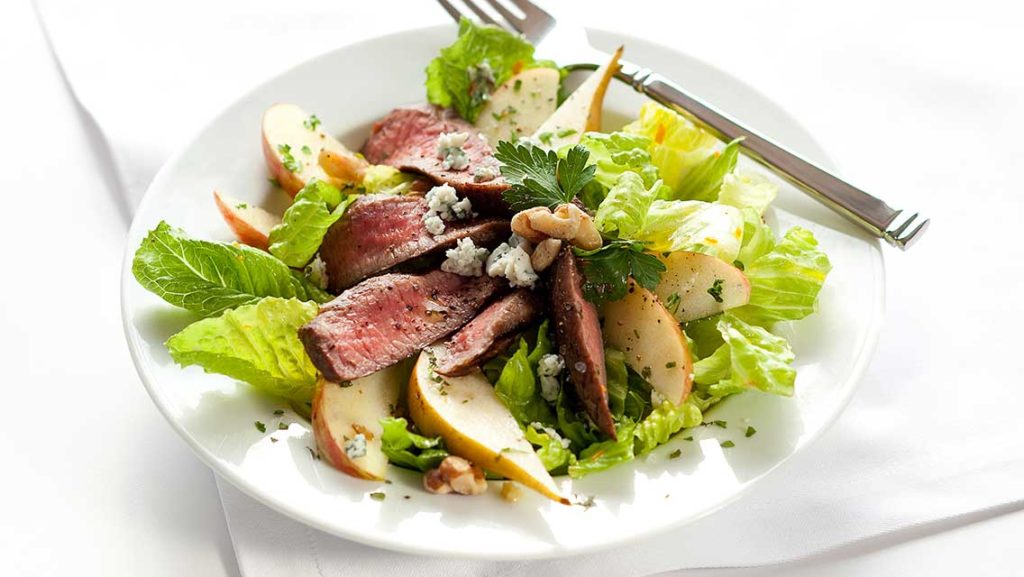
Makes | four servings
Orange Basil Vinaigrette
- 1/4 cup extra-virgin olive oil
- 1/4 orange, zested
- Juice of one orange
- 1/4 tsp. salt
- 1 tbs. honey
- 2 tbs. chopped fresh basil
- 1 tsp. rice wine vinegar
Beef
- 12 ounces grass-fed beef sirloin, cut into 3-ounce portions
- 1/4 tsp. extra-virgin olive oil
- 1/4 tsp. sea salt
- 1/4 tsp. freshly ground black pepper
Salad
- 6 cups chopped romaine lettuce
- 1 apple, sliced
- 1 pear, sliced
- 1/2 cup toasted walnuts
- 1/2 cup crumbled blue cheese
Directions
- For the vinaigrette: Mix the olive oil, orange zest, orange juice, salt, honey, basil and vinegar in a jar with a lid. Seal and shake well.
- For the beef: Preheat the oven to 400 degrees F. On the stovetop, heat a grill pan over medium-high heat and lightly coat with olive oil. Season the beef with salt and pepper. Add to the grill pan and sear on all sides, about one minute per side. Place the sirloin in the oven and bake for eight to 10 minutes (to medium rare).
- For the salad: Toss the romaine with 1/2 cup orange basil vinaigrette. On each plate, place 1½ cups of romaine and arrange one-fourth of each pear and apple. Sprinkle with chopped walnuts and crumbled blue cheese. Slice each serving of beef into thin strips and fan out on top of the salad.
Beef Hot-Pot Soup
This basic version of a classic Asian beef soup makes a little beef go a very long way. For a vegetarian option, replace sirloin with extra edamame beans.
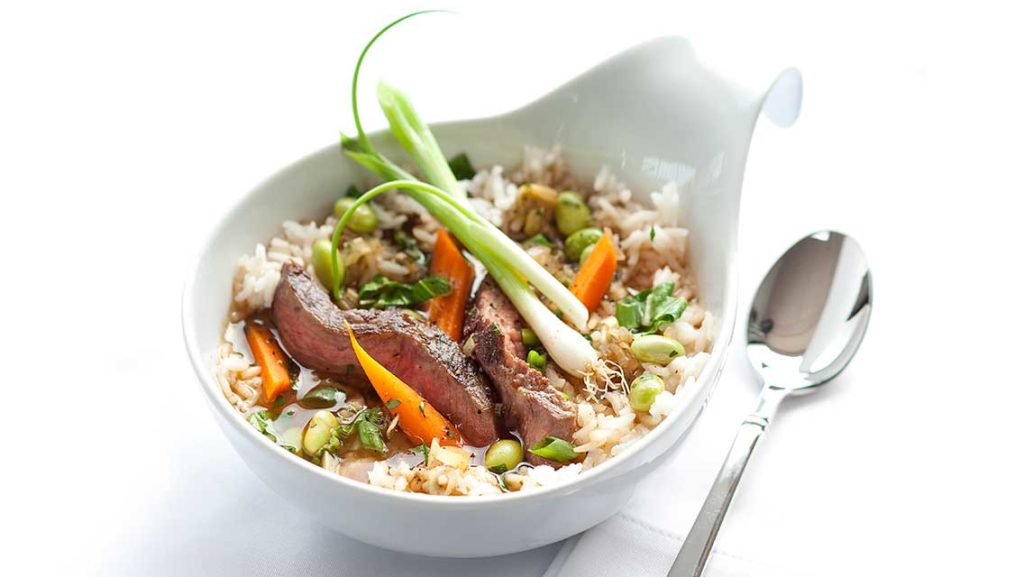
Makes | four servings
- 2 tbs. olive oil, divided
- 1 tsp. minced shallots•
- 1 tsp. fish sauce
- 1/4 cup finely chopped lemongrass
- 1 tbs. tomato paste
- 3 cups beef stock
- 1 tbs. minced cilantro
- 1/4 tsp. sea salt
- 1/8 tsp. freshly ground black pepper
- 4 2-ounce medallions of grass-fed beef sirloin
- 8 baby carrots, sliced
- 1/2 cup thinly shredded bok choy
- 1/2 cup edamame beans
- 2 cups cooked jasmine rice
- 1 tbs. chopped scallions
Directions
- Heat a medium saucepan and add 1 tablespoon olive oil. Sauté shallots for about one minute, then add the fish sauce, lemongrass and tomato paste. Bring to a boil and stir in beef stock. Simmer for 20 minutes, stir in cilantro, salt and pepper.
- Preheat the oven to 400 degrees F. Season both sides of the beef with salt and pepper. Heat a sauté pan over high heat and add remaining olive oil. Sear the beef on both sides. Place in preheated oven and cook for five minutes for medium-rare steak.
- Just before serving soup, add the carrots, bok choy and edamame beans to the soup base and cook for about one minute.
- Place 1/2 cup of rice in each of four bowls. Divide soup among the soup bowls. Slice beef on the bias and fan out over the rice and vegetables. Sprinkle each bowl with scallions.
Beef and Barley Mushroom Salad
This flavorful grain salad works well as an entrée or a hearty side. For a vegetarian version, substitute some beans and extra veggies.

Makes | six servings
- 1 cup dry pearl barley
- 2 cups sliced portabella mushrooms, gills removed
- 2 1/2 cups vegetable stock
- 3/4 cup shredded, roasted grass-fed beef (or leftover steak)
- 1/2 cup finely chopped red bell pepper
- 2 tbs. chopped parsley
- Salt and pepper to taste
Balsamic Dressing
- 2 tbs. balsamic vinegar
- 1/4 cup extra-virgin olive oil
- 1/2 tsp. Dijon mustard
- 1/2 tsp. honey
Directions
- Heat the barley in a medium saucepan over medium heat to lightly brown. Stir constantly, about four minutes.
- Add the mushrooms and vegetable stock, bring to a boil, then reduce heat, cover and simmer about 25 minutes until the barley is soft. Remove from heat and drain.
- Whisk dressing ingredients to emulsify. Combine the remaining ingredients in a large bowl and toss with 1/4 cup balsamic dressing.
- Chill for at least 30 minutes before serving.
Tips for a Great Grass-Fed Burger
- When preparing grass-fed hamburgers on the grill, add caramelized onions, minced mushrooms, shredded zucchini, chopped olives or roasted peppers to the meat to add moisture while cooking.
- When grilling, whether on an outdoor grill or in a grill pan, sear the meat quickly over a high heat on each side to seal in its natural juices. Then reduce the heat to medium or low to finish the cooking process.
- Make sure you do not overcook your burgers. Grass-fed beef can go from perfectly cooked to overcooked in less than a minute, so use a thermometer to ensure doneness (rare 120 degrees, medium rare 125, medium 130).
- Get creative with fresh herbs, spices, vinegars and sauces when making toppings for your burgers.
The Great Grass-Fed Burger
Makes six burgers
- 2 tbs. butter or vegetable oil
- 1 cup finely chopped sweet onion
- 1 1/2 pounds grass-fed, extra-lean ground beef
- 1 cup finely chopped mushrooms
- 1 tbs. Worcestershire sauce
- 1/2 tsp. salt
- 1/2 tsp. freshly ground black pepper
- 6 slices cheddar, Swiss or Gouda cheese
- 6 whole-wheat burger buns or Ciabatta rolls
- Romaine lettuce/arugula/heirloom tomato slices
- Favorite toppings (mustards, ketchup, infused mayo, salsa, relish)
Directions
- In a medium sauté pan, heat the butter or oil over medium heat and add the onions. Cook, stirring occasionally, until the onions are deep golden brown, about 15 minutes. Cool the onions completely.
- In a mixing bowl combine the ground beef with the caramelized onions, mushrooms, Worcestershire, salt and pepper and divide the mixture into six portions. Roll each portion into a ball and flatten them out to about 3/4-inch thick.
- Preheat the gas or charcoal grill to high. Cook the burgers for three to four minutes on the first side to seal in the juices, and then reduce heat to medium.
- Turn burgers over and cook on the other side for another three or four minutes or until a thermometer inserted in the center of the meat reads 120 to 130 degrees, depending on how you like the burger cooked.
- Place a slice of cheese on top of each burger in the last minute of cooking. Remove them from the grill and layer onto buns with lettuce, tomato and your favorite toppings.
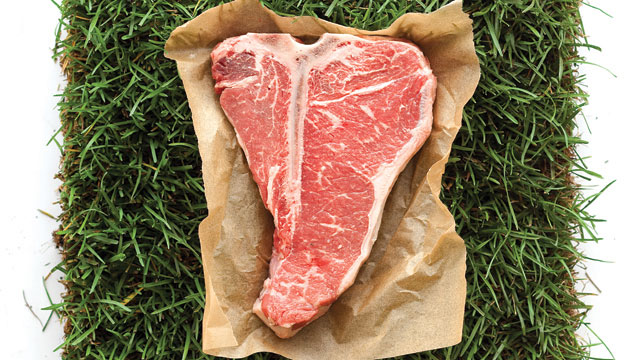
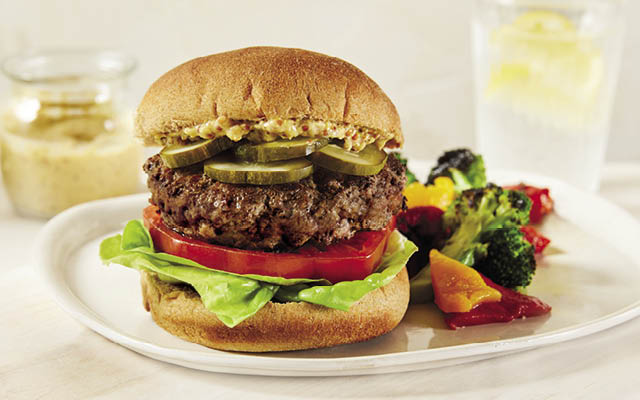

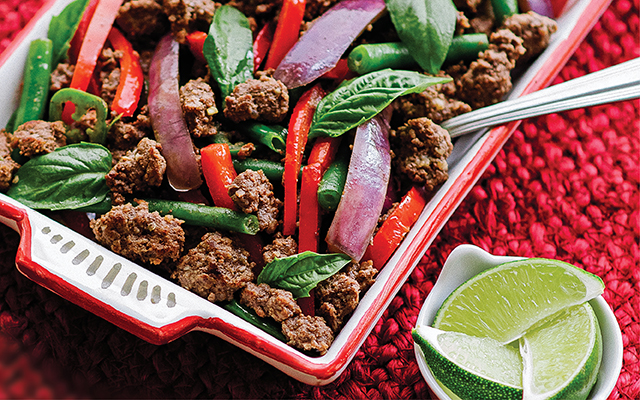
This Post Has 0 Comments